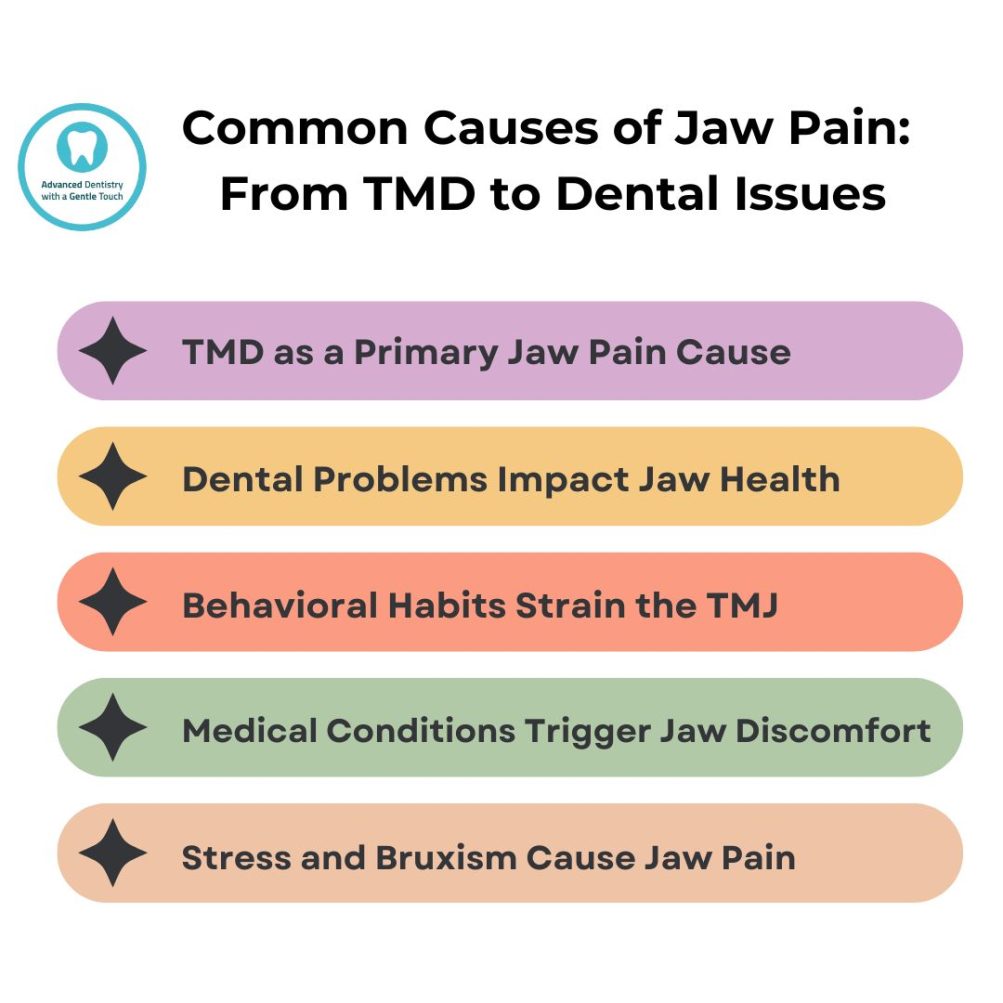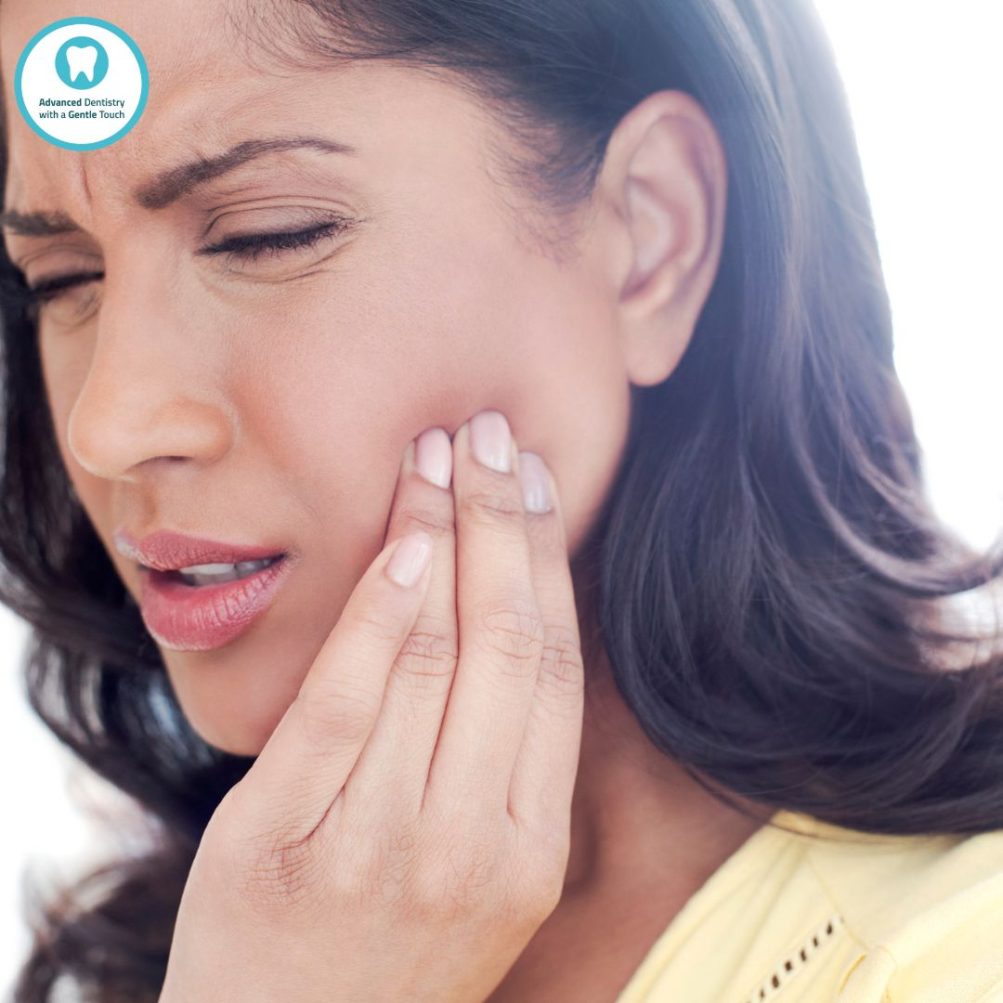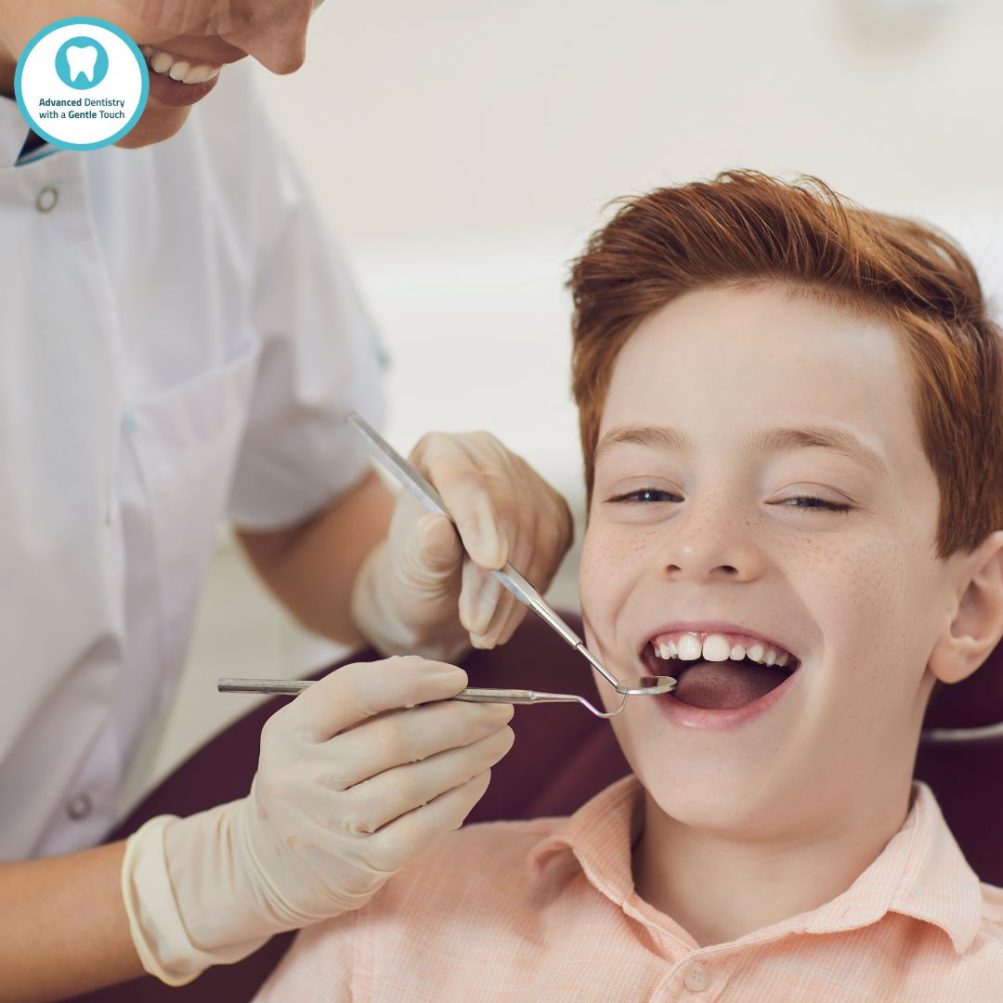Common Causes of Jaw Pain: From TMD to Dental Issues

Jaw pain is a common issue that can significantly impact daily life, making simple activities like eating or speaking uncomfortable. It can range from a mild ache to severe discomfort and often affects areas near the ear or along the jawline. Jaw pain can stem from various causes, including dental issues and sinus infections. Temporomandibular joint (TMJ) disorders can also cause jaw pain, which may require specialized TMJ treatment for effective relief.
Understanding the underlying causes of jaw pain is crucial for effective treatment and relief. Conditions like TMD, tooth misalignment, or infections can worsen over time if left untreated, potentially affecting overall health. Additionally, symptoms such as swelling on the jaw or pain when opening the mouth may indicate more serious conditions requiring immediate attention.
This blog explores the common causes of jaw pain, their symptoms, and the treatment options available. By recognizing the signs and seeking timely care from a dental professional, individuals can manage their discomfort and improve their quality of life. Whether the pain is sudden or persistent, understanding its root cause is the first step toward lasting relief.

Temporomandibular Joint Disorder (TMD)
The temporomandibular joint (TMJ) plays an important role in jaw function. It connects the jawbone to the skull and enables movements like chewing and speaking. Temporomandibular Joint Disorder (TMD), however, refers to a group of conditions that cause pain and dysfunction in this joint.
Unlike general jaw pain, TMD often involves specific issues such as clicking, locking, or restricted movement of the jaw. This disorder is common, affecting millions of people worldwide, and can significantly impact daily activities.
What is TMD?
TMD encompasses conditions that disrupt the normal function of the TMJ, leading to discomfort and reduced mobility. It differs from general jaw pain by involving structural or functional problems in the joint or surrounding muscles.
Common symptoms of TMD include jaw clicking or popping sounds, difficulty opening or closing the mouth, and a locked jaw. For many, TMD symptoms can also extend to headaches, pain near the ear, and tenderness when pressing along the jawline. Understanding these unique features of TMD is essential for identifying and managing the condition.
Causes of TMD
Several factors contribute to the development of TMD. Jaw misalignment or malocclusion can put stress on the TMJ, while habits like bruxism (teeth grinding) place excessive pressure on the joint. Stress is another significant cause, often leading to clenching of the jaw muscles, which can strain the TMJ over time.
Additionally, arthritis, particularly rheumatoid or osteoarthritis, can affect the joint’s functionality. Injuries, such as a direct blow to the jaw or overuse from activities like frequent gum chewing, can also lead to TMD.
Recognizing TMD Symptoms
TMD symptoms are often recognizable and include jaw tenderness, persistent headaches, and ear pain. Individuals may notice difficulty opening or closing their mouth fully, with some experiencing pain under the ear behind the jaw bone on the left side or a clicking sound during movement.
Persistent symptoms like swelling, limited motion, or sudden jaw pain on both sides should prompt a visit to a dentist or healthcare provider. Timely intervention is key to managing TMD and preventing further complications.

Dental Causes of Jaw Pain
Jaw pain is often linked to dental issues that can cause discomfort and impact overall oral health. Problems such as tooth decay, misaligned teeth, and gum disease can lead to pain radiating through the jaw and surrounding areas. Addressing these dental causes promptly is essential for relieving symptoms and preventing further complications.
Tooth Decay and Cavities
Untreated tooth decay is a common source of jaw pain. When a cavity progresses, it can reach the tooth’s inner pulp, leading to inflammation and infection. This pain may radiate to the jaw, causing discomfort when chewing or speaking. In severe cases, an abscess can develop, creating pressure and swelling near the affected tooth.
See also Dr. Korwin Thanks His Patients
An abscess not only contributes to jaw discomfort but may also cause additional symptoms, such as a sore jaw with a cold or localized swelling on the jaw. Treating cavities and infections early can prevent these painful outcomes.
Impacted or Misaligned Teeth
Wisdom teeth impaction or overcrowding can place significant stress on the jaw, often resulting in pain. Impacted teeth, which fail to fully erupt, can press against neighboring teeth, leading to soreness and inflammation.
Similarly, misaligned teeth or a poor bite (malocclusion) can strain the jaw muscles and joints over time. This strain may cause jaw pain on one side when opening the mouth or discomfort when eating. Orthodontic treatments, such as braces or aligners, can help correct these issues and reduce jaw-related pain.
Gum Disease and Oral Infections
Periodontitis and other gum infections can also contribute to jaw pain. Inflammation in the gums may spread to surrounding tissues, resulting in discomfort that extends to the jaw. Common signs of gum disease include swelling, bleeding gums, and tenderness in the jaw area.
For instance, individuals may experience a sore throat and jaw pain or wake up with jaw pain on the left side due to gum-related issues. Proper oral hygiene and timely dental care are crucial for preventing gum infections and alleviating associated jaw pain.
By addressing these dental causes of jaw pain, individuals can improve their oral health and find relief from persistent discomfort.

Behavioral and Lifestyle Factors Contributing to Jaw Pain
Jaw pain can often be linked to certain behavioral and lifestyle factors that place stress on the temporomandibular joint (TMJ) and surrounding muscles. Habits such as teeth grinding, poor posture and excessive chewing are common culprits that can lead to persistent discomfort and other related symptoms. Identifying and addressing these behaviors can play a significant role in alleviating jaw pain.
Bruxism (Teeth Grinding)
Bruxism, or teeth grinding, is a frequent cause of jaw pain. This condition occurs when a person clenches or grinds their teeth, often unconsciously, during sleep. Stress, anxiety, and sleep disorders are common triggers of bruxism, which can place excessive pressure on the TMJ.
Over time, this can lead to soreness, inflammation, and symptoms like waking up with sore jaws or experiencing jaw pain when opening the mouth. Managing stress and using a mouthguard at night can help reduce its impact on the jaw.
Poor Posture
Poor posture, especially in the neck and shoulders, can strain the jaw over time. Slouching or holding your head in a forward position places undue pressure on the TMJ. Everyday habits, such as cradling the phone between your shoulder and ear or resting your chin on your hand, exacerbate this issue. These behaviors can lead to jaw pain on one side or discomfort radiating to the neck and shoulders. Maintaining proper alignment and avoiding these habits can ease jaw-related strain.
Excessive Chewing or Clenching
Frequent gum chewing, nail-biting, or clenching the jaw can overwork the muscles, resulting in fatigue and pain. These repetitive movements place continuous stress on the TMJ, potentially causing soreness or stiffness.
For some, this may manifest as sudden jaw pain on both sides or jaw pain when opening the mouth widely. Limiting these habits and giving the jaw muscles time to relax can prevent further discomfort.
Medical Conditions Causing Jaw Pain
Jaw pain is not always due to dental or behavioral issues; it can also result from underlying medical conditions. Disorders such as arthritis, neuralgia, and sinus infections can contribute to discomfort in the jaw, often accompanied by other symptoms. Recognizing these conditions is essential for accurate diagnosis and effective treatment.
See also Happy Dental Patient at Dr Korwin's
Arthritis and Joint Disorders
Both rheumatoid arthritis and osteoarthritis can affect the temporomandibular joint (TMJ), leading to significant jaw pain. Rheumatoid arthritis, an autoimmune condition, causes inflammation in the joints, including the TMJ, while osteoarthritis leads to joint degeneration over time.
Common symptoms include stiffness, swelling, and reduced mobility in the jaw, which can make simple activities like chewing or speaking difficult. For some, these conditions can also cause jaw pain on one side when opening the mouth or stiffness that worsens in the morning.
Neuralgia and Nerve Disorders
Trigeminal neuralgia, a condition affecting the trigeminal nerve, is a severe cause of facial and jaw pain. This disorder is characterized by sharp, shooting pain that can be triggered by everyday activities like talking or eating.
Other nerve-related conditions, such as temporomandibular joint dysfunction (TMD), can mimic these symptoms. These often cause pain under the ear or along the jawline. Proper evaluation is critical to distinguish nerve disorders from other causes of jaw pain.
Sinus Infections
Sinus infections, particularly maxillary sinusitis, can radiate pain to the upper jaw, creating discomfort that may be mistaken for dental issues. Symptoms such as facial pressure, nasal congestion, and jaw ache with a cold are common indicators.
In some cases, the combination of a sore jaw and throat may point to sinus-related problems. Treating the infection often alleviates these symptoms.

Diagnosing the Cause of Jaw Pain
Accurately diagnosing the cause of jaw pain is essential for effective treatment and relief. Since jaw pain can stem from various sources, a thorough evaluation is required to pinpoint the root cause. This process typically involves a combination of clinical examinations and diagnostic imaging.
Clinical Examination
A detailed clinical examination is the first step in diagnosing jaw pain. Your healthcare provider will palpate the jaw and neck muscles to check for tenderness, swelling, or stiffness. This hands-on assessment helps identify potential issues with the temporomandibular joint (TMJ) or surrounding tissues.
A comprehensive dental and medical history review is also crucial. It provides insights into factors such as teeth grinding, previous injuries, or systemic conditions like arthritis. For example, a history of waking up with sore jaws or jaw pain when opening the mouth might indicate habits or underlying conditions affecting the TMJ.
Imaging and Tests
Diagnostic imaging is often used to confirm the findings from the clinical exam. Tools such as X-rays, CT scans, and MRIs are instrumental in identifying structural problems, such as TMJ misalignment or damage caused by arthritis.
For more complex cases, blood tests may be needed to rule out systemic conditions like rheumatoid arthritis, which can cause stiffness and inflammation in the jaw. Imaging can also help differentiate between dental issues and other conditions, such as sinus infections, that might result in jaw pain.
Treatment Options for Jaw Pain
Finding the right treatment for jaw pain depends on the underlying cause. Whether the pain is related to temporomandibular joint disorder (TMD), dental issues, or behavioral habits, there are various options available to alleviate discomfort and restore jaw function. These treatments range from non-invasive therapies to more advanced interventions for severe cases.
Treating TMD
Non-invasive treatments are often the first line of defense for managing TMD. Bite guards or splints can help reduce strain on the temporomandibular joint (TMJ) by preventing teeth grinding, especially for those who wake up with sore jaws.
See also Single Dental Implants and Their Benefits
Physical therapy, including exercises to strengthen jaw muscles, is another effective option. Stress management techniques, such as relaxation exercises or counseling, can also alleviate symptoms, as stress is a common trigger for TMD. In severe cases where these methods do not provide relief, surgical options like arthroscopy or open-joint surgery may be necessary to correct structural issues within the TMJ.
Addressing Dental Issues
Dental problems such as cavities, gum disease, and impacted teeth can contribute to jaw pain and should be treated promptly. Untreated cavities or infections can lead to swelling on the jaw and radiating pain, while impacted teeth may require extraction to relieve discomfort.
Orthodontic treatments, like braces or aligners, can correct misaligned teeth or bites, reducing stress on the jaw muscles and preventing issues like jaw pain on one side when opening the mouth.
Managing Behavioral Causes
Addressing behavioral habits can significantly reduce jaw pain. Stress reduction techniques, such as mindfulness or yoga, can prevent clenching or grinding that often exacerbates TMD symptoms. Using a mouthguard during sleep helps protect the TMJ from damage caused by bruxism.
Additionally, avoiding excessive chewing of gum or hard foods minimizes strain on the jaw muscles, helping to prevent sudden jaw pain on both sides.

Preventing Jaw Pain
Preventing jaw pain often involves making simple lifestyle changes and being proactive about oral health. By maintaining healthy habits and seeking professional help when needed, individuals can minimize discomfort and reduce the risk of long-term issues related to the jaw.
Healthy Habits
Adopting healthy habits plays a key role in preventing jaw pain. Maintaining good posture, especially in the neck and shoulders, helps reduce strain on the temporomandibular joint (TMJ). Managing stress is equally important, as it often leads to teeth clenching or grinding, which can worsen jaw pain.
Avoiding repetitive jaw movements, such as excessive gum chewing, can also reduce the likelihood of muscle fatigue. Regular dental check-ups are essential for catching oral health issues, like cavities or gum disease, early. Addressing these concerns promptly prevents complications that may lead to symptoms such as waking up with sore jaws or jaw pain when opening the mouth.
When to Seek Professional Help
Knowing when to seek professional help is crucial for preventing jaw pain from worsening. Persistent or worsening symptoms, such as jaw pain on one side or swelling on the jaw, warrant immediate attention. Early intervention can prevent complications like chronic TMJ disorders or structural damage.
For those living in Red Bank, Middletown, or surrounding areas, consulting Dr. Korwin, a Red Bank dentist, ensures timely treatment. By addressing concerns early, individuals can protect their jaw health and avoid long-term discomfort.
Conclusion
Jaw pain is a common issue that can arise from various causes, such as TMD, dental problems, stress, or infections. These conditions can significantly impact daily activities like eating, speaking, or even sleeping. Understanding the root cause is the first step toward finding relief, whether it’s due to teeth grinding, misalignment, or an underlying infection. Ignoring jaw pain may lead to further complications, so addressing it early is essential for maintaining your quality of life.
If you are experiencing symptoms like jaw pain on the left side, sore throat, jaw pain, or discomfort that does not seem to go away, it is time to take action.
Do not let jaw pain control your life. Schedule a consultation with Dr. Korwin today and take the first step toward feeling better. Whether your symptoms are mild or severe, you can trust that you are in expert hands, ready to help you find the relief you deserve.
